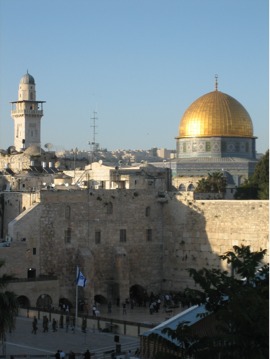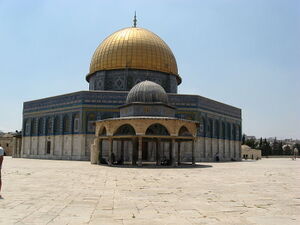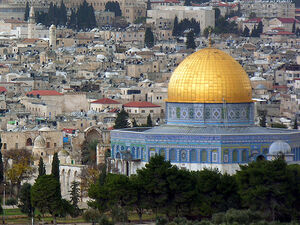Dome Of The Rock
 From Conservapedia
From Conservapedia | Dome of the Rock | |
|---|---|

| |
| Arabic name | |
| Arabic | قبة الصخرة |
| Romanization | Qubbat aṣ-Ṣakhra |
The Dome of the Rock[1] is an Islamic shrine in Jerusalem. It is the high point of the Temple Mount, biblical Mount Moriah. Muhammed said that in a dream he ascended to "heaven" from the Temple Mount, which Muslims refer to as the "Noble Sanctuary."[2]
Muslim authorities do not accept the tradition that Mohammad ascended from the Rock specifically.[3] The Temple Mount is Islam's third holiest site. The dome was built in 691, making it one of the oldest examples of notable Islamic architecture.
In Jewish tradition, the rock under the dome is identified with the foundation stone on which the Ark of the Covenant rested at the Temple.[4] The foundation stone is where Abraham offered up his son Isaac,[5] and it is the part of the world that came into being first during creation.[6]
The base of the Dome is an octagon. The Byzantine Church of Mary's Rock in Jerusalem has been suggested as an inspiration for this unusual shape.
Contents
- 1 Relationship to the Temple
- 1.1 At the Dome
- 1.2 Northern location
- 1.3 Southern location
- 1.4 City of David
- 2 History
- 3 References
- 4 See also
- 5 External links
Relationship to the Temple[edit]

At the Dome[edit]
The most widely accepted view is that the Temple was where the Dome now stands. This central location theory was outlined by Rabbi David ben Zimra (“Radbaz” [1461–1571]). In modern times, the theory is identified with architect Leen Ritmeyer. It follows that the Rock was the Foundation Stone of the Herodian temple. The Foundation Stone was in an area of the Temple called the Holy of Holies.
One difficulty with this view is that the rock housed under the Dome is 58 by 51 feet. Yet the Holy of Holies was only 20 by 20 cubits, or 30 by 30 feet. The Foundation Stone was a platform that rose "three fingers" above the Temple floor, according to the Mishna.[7] The Rock is 5 foot, 9 inches above the floor of the shrine. Furthermore, the top of the Rock appears to have been quarried at some point, suggesting that it was once even higher.
Northern location[edit]
The northern location theory of physicist Asher Kaufman places the Temple north of the Dome, with the Holy of Holies located at what is now the Shrine of the Spirits. This is due west of the blocked Golden Gate, a subject of messianic prophesy.[8] A review in Biblical Archaeological Review complained that Kaufman's "reconstruction of the Inner and Outer Courts of the Temple [are] geographically and physically untenable."[9]
Southern location[edit]
Architect Tuvia Sagiv has proposed a southern location theory that places the Holy of Holies at the site of Al Kas fountain, south of the Dome. Sagiv suggests that Hadrian's Jerusalem temple followed the plan of a temple built by Hadrian in Baalbek, Lebanon. In this view, the Dome was built on the ruins of the hexagonal forecourt of the classical temple.[10]
If the Holy of Holies was at El Kas, the Wailing Wall is the portion of the Temple retaining wall that is closest to the western wall of the former Holy of Holies. The divine presence never moves from this location, according to the Midrashim. Jews have prayed at the Wailing Wall since the 16th century. [11]
City of David[edit]
Meteorologist Ernest Martin argues that the Temple was not on the Temple Mount at all, but rather in the City of David, which is located in a valley just south of the Temple Mount.[12] This theory ignores numerous biblical verses that specify that the Temple was on a mountaintop. For example, 2 Chronicles refers to, "the altars that he had built on the mountain of the house of the LORD and in Jerusalem,"[13] while Micah says, "It shall come to pass in the latter days that the mountain of the house of the LORD shall be established as the highest of the mountains, and it shall be lifted up above the hills; and peoples shall flow to it."[14]
The dispute is not only about archeology and religion, but also politics. While the central location theory upholds rabbinic orthodoxy, Kaufman, Sagiv, and Martin want to rebuild the Temple and have selected locations where this might be possible.
History[edit]

After the Romans destroyed the Second Temple in AD 70, Jerusalem was rebuilt as a Roman city called Aelia Capitolina. Emperor Hadrian landscaped the Temple Mount and built a temple to Jupiter on the site in 135. In 325, Emperor Constantine tore down this temple.[15]
The Bordeaux pilgrim visited the site in 333.
| “ | There are two status of Hadrian; not far from the statues is a pierced stone to the Jews comes every year and they anoint it and they lament with a groan and they tear their garments and then they withdraw.[16] | ” |
According to legend, when the first Muslim conquerors took Jerusalem, they approached the Temple Mount. There, the conqueror Umar (or Omar) called the Christian Patriarch Sophronius of the city before him to answer for the derelict state of the holy site. Insisting that such a site, sacred to all three religions, deserved respect, Umar insisted that the patriarch himself begin cleaning the mount.
The dome was built shortly thereafter, first in a primitive, wooden state from 687 to 691 by Caliph Abd al-Malik ibn Marwān as a placeholder, and in its final spectacular version somewhat later. It suffered from earthquakes in 746, 1033, and 1927.
The association between the Dome of the Rock and the Jewish Temple first appears in the Pirke De-Rabbi Eliezer, written in the ninth century. The Crusaders called the Dome the "Temple of God" and used it as a church.

Maimonides, the best known authority on Jewish law, prayed on the Temple Mount in 1165. "Even though, the Temple is now in ruin because of our sins, a person must hold its [site] in awe, as one would regard it when it was standing," he said.[17] Maimonides issued a law code which states, "Therefore, every Jew should avoid entering the central area of the Temple Mount both because of the prohibition of entering the sanctified area of the Temple and because of the positive commandment of venerating the Temple."[18]
The Temple proper was 400 by 400 cubics, according to Josephus. A cubic was about 0.44 meters. Thus the sanctified area is just a small portion of the Temple Mount.
Since at least 1600, Jewish religious leaders have held that Jews are not allowed enter any part of the Temple Mount. Instead, modern Jews pray at the Western Wall. Since the locations of forbidden areas, such as the Rampart or the Court of Women, are no longer known, there is a risk that someone who enters the Temple Mount will trespass into them.[19]
This shrine was covered by a lead dome from 691 until it was replaced with a gold-colored covering in 1965. Because of rust, the anodized aluminum cover was again replaced in 1993 with a gold covering.[20]
The Waqf, a Muslim group financed by the Jordanian government, manages the Temple Mount-Haram al-Sharif and consequently the Dome of the Rock.
References[edit]
- ↑ Qubbat aṣ-Ṣakhra, قبة الصخرة
- ↑ Tamar Mayer, Suleiman A. Mourad, "Jerusalem: Idea and Reality," Routledge, (2008), p. 87.
Most of those who asserted that Muhammad could have seen Jerusalem—making the connection between the Aqsa mosque and Jerusalem's Temple Mount area—admitted that the vision was in the form of a dream
- ↑ "Masjid al-Aqsa", Islamic Encyclopedia, Mon, 13 Oct, 2014.
- ↑ Temple Inst.
The Foundation Stone.
In the center of the Holy of Holies stood the Foundation Stone that was placed there by David and Samuel. The Hebrew name Even Shetiya (Foundation Stone) refers to the tradition that the world was created and emanated from this place. The measurement of the stone was three "fingers" high.
During the era of the Second Temple, when the Ark was hidden underground, the High Priest would offer the incense of Yom Kippur in the Holy of Holies without the presence of the Ark, and rest the shovel holding the burning coals and incense upon the foundation stone... - ↑ Genesis 22:1-24
- ↑ Job 38:4
- ↑ Blidstein, Gerald Y., "Even Shetiyyah," Encyclopedia Judaica, 1996.
- ↑ Ezekiel 44
- ↑ Schwartz, Joshua, "The Temple Mount: Where Is the Holy of Holies?," Bible History Daily, January 11, 2012.
- ↑ "The Temple Mount in Jerusalem"
- ↑ "Western Wall," Encyclopaedia Judaica Auerbach.
- ↑ "The Lost Temple Mount Found"
- ↑ 2 Chronicles 33:15
- ↑ Micah 4:1
- ↑ "The Temple in Jerusalem was not located over the Dome of the Rock"
- ↑ The Bordeaux Pilgrim (c. 333 C.E.). Translation by Andrew S. Jacobs.
- ↑ "Maimonides on the Temple Mount"
- ↑ Bet Habehirah 7:7.
- ↑ Levy, Rafael, "'Refrain from entering entire Temple Mount area'," Israel National News, 24.02.19.
- ↑ Will the Third Temple be Built in Jerusalem?
See also[edit]
- Israel
- Judaism
- Third Temple
External links[edit]
- Dome of the Rock.
- Caliph Umar Brings Peace and Justice to Palestine.
- Dome of the Chain, Temple Mount, Jerusalem.
- Dome of the Chain.
Categories: [Islam]
↧ Download as ZWI file | Last modified: 03/09/2023 18:21:44 | 7 views
☰ Source: https://www.conservapedia.com/Dome_of_the_Rock | License: CC BY-SA 3.0
 ZWI signed:
ZWI signed:


 KSF
KSF